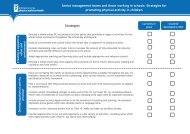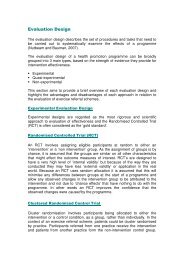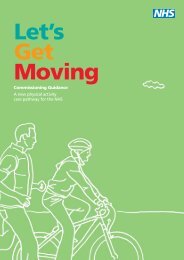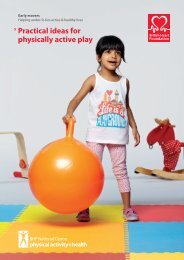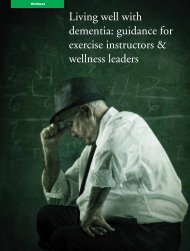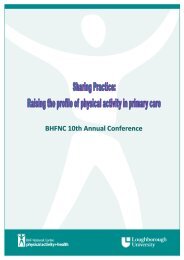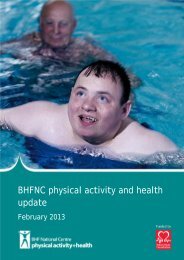Physical activity statistics 2012 - British Heart Foundation
Physical activity statistics 2012 - British Heart Foundation
Physical activity statistics 2012 - British Heart Foundation
- No tags were found...
Create successful ePaper yourself
Turn your PDF publications into a flip-book with our unique Google optimized e-Paper software.
50 <strong>Physical</strong> Activity Statistics, <strong>2012</strong>4. Types of physical <strong>activity</strong>The World Health Organization warns that physical <strong>activity</strong> should not be mistakenfor sport. <strong>Physical</strong> <strong>activity</strong> is any bodily movement produced by the skeletal musclesthat uses energy. This includes sports, exercise and other activities such as playing,walking, doing household chores or gardening 1 . Recent research has estimated theenergy expenditure of domestic activities, allowing us to highlight the potentialcontribution of these activities to promote health 2 . This chapter shows differenttypes of physical <strong>activity</strong> levels in England categorised by non-occupational andoccupational settings. Occupational <strong>activity</strong> refers to those performed whilstworking, non-occupational to all those activities performed outside of paid work.Non-occupational physical <strong>activity</strong> levelsThe Health Survey for England 2008 examined thenumber of hours spent on different activities 3 . Both men(2.2 hours/week) and women (1.9 hours/week) spent morehours per week walking than other non-occupationalactivities. Time spent in heavy house work remainedrelatively stable across age groups for both men andwomen. Overall, men reported more hours spent innon-occupational physical <strong>activity</strong> (6 hours/week) thanwomen (5 hours/week) (Table 4.1, Figure 4.1).Around 23% of men reported that they participate inheavy house work for more than an hour per week,with this declining after the age of 55 years. A similartrend was found with heavy manual gardening andDIY. More than two thirds of men walked less than onehour per week and the proportion who walked morethan one hour per week started to decline after 44years of age. More than 50% of men spent less than onehour per week participating in sports and exercises,with this proportion declining with age. Almost 30%of men spent less than one hour in any type of nonoccupationalphysical <strong>activity</strong> (Table 4.2a, Figure 4.2a).Women aged 25 to 64 spent more time in heavy housework than the younger and older age groups. Themajority of women (88%) reported that they did notspend any time in heavy manual/gardening or DIY workand more than half of women (56%) did not spend anytime in sports and exercise, with a similar pattern ofdecreasing participation with increasing age as foundwith men. Around two thirds (66%) of women reportedsome sort of non-occupational physical <strong>activity</strong> formore than one hour per week which started to declineafter 35 years of age (Table 4.2b, Figure 4.2b).Both men and women reported walking and sportsand exercise as the non-occupational activities with thehighest number of days participation in the last fourweeks. On average men participated in non-occupationalphysical <strong>activity</strong> on 14 days during the last four weekscompared to 12.2 days for women. The average numberof days of physical <strong>activity</strong> participation declined withage for both men and women (Table 4.3, Figure 4.3)Occupational physical <strong>activity</strong> levelsAround one in four men (24%) reported moderate tovigorous occupational <strong>activity</strong> for at least 30 minutesper day compared to one in ten women. The highestlevels of occupational physical <strong>activity</strong> were reportedfor the youngest age group for men (16 to 24 years)and above 55 years of age for women. A greaterproportion of time at work was spent sitting or standingthan anything else, whilst the most common form ofphysical <strong>activity</strong> at work for both men and womenwas walking (Tables 4.4a and 4.4b, Figure 4.4).1. World Health Organization (2011). Global recommendationson physical <strong>activity</strong> for health. WHO: Geneva.2. Weller I, Corey P (1998). The impact of excluding non-leisureenergy expenditure on the relation between physical<strong>activity</strong> and mortality in women. Epidemiology, 9:632–5.3. Joint Health Surveys Unit (2010). Health Survey for England 2008:<strong>Physical</strong> <strong>activity</strong> and fitness. The Information Centre: Leeds.



